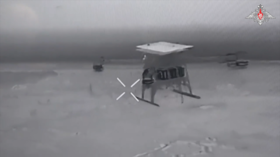Snot funny: Endangered seals have an eely big problem (PHOTO)

A breed of endangered Hawaiian seals are facing an unexpected – and unpleasant – new threat, as pesky eels keep getting mysteriously jammed in their nostrils.
The Hawaiian Monk Seal Research Program (HMSRP) shared a photograph of a monk seal with one of the slippery creatures dangling out of its nose this week, in just the latest such incident to strike the rare mammals in recent times.
“We have now found juvenile seals with eels stuck in their noses on multiple occasions,” HMSRP wrote. “In all cases the eel was successfully removed and the seals were fine.”
Also on rt.com White lion Mufasa locked in bizarre custody battle, fears animal could be sold to huntersThe eels were less fortunate – none of them survived the extraction.
The first such eel booger was spotted in 2016 and researchers still don’t have an explanation for why this is happening. In each case, it was a juvenile seal which had an eel lodged in its nasal passage.
The program’s lead scientist Charles Littnan told the Washington Post that the first time the team pulled an eel out, it was like a “magician's trick when they're pulling out the handkerchiefs and they keep coming and coming and coming.”
Although the seal pictured looks pretty chilled out despite the wriggly creature lodged in its nose, researchers fear the eels could cause infections or affect the mammals’ diving abilities.
One theory being floated is that the eels are getting trapped in the seals’ noses when trying to escape their clutches. Another possibility is that the seals are regurgitating the eels through their nose, as seals sometimes regurgitate their food.
READ MORE: Cocaine in British waters affecting sex lives of eels, study finds
Littnan thinks it’s possible the seals are just acting like human teenagers, doing silly things they shouldn’t. “It almost does feel like one of those teenage trends that happen,” he said. “One juvenile seal did this very stupid thing and now the others are trying to mimic it.”
Monk seals are found in Hawaii and there are only about 1,400 left.
Think your friends would be interested? Share this story!














